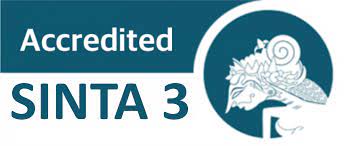A Review of the Blended Learning as the Model in Improving Students` Paragraph Writing Skills
Abstract
Keywords
Full Text:
PDFReferences
Alqahtani, A. Y., & Rajkhan, A. A. (2020). E-learning critical success factors during the covid-19 pandemic: A comprehensive analysis of e-learning managerial perspectives. Education sciences, 10(9), 216.
Alsalhi, N. R., Eltahir, M. E., & Al-Qatawneh, S. S. (2019). The effect of blended learning on the achievement of ninth grade students in science and their attitudes towards its use. Heliyon, 5(9), 1-11.
Alsmari, N. A. (2019). Fostering EFL students' paragraph writing using edmodo. English Language Teaching, 12(10), 44-54.
Atayeva, M., Putro, N. H. P. S., Kassymova, G., & Kosbay, S. (2019). Impact of reading on students’ writing ability. In Materials of International Practical Internet Conference “Challenges of Science (Vol. 144, No. 2, pp. 5-13).
Boardman, C. A., & Frydenberg, J. (2008). Writing to communicate 2: Paragraph and essays, Third Edition. New York: Pearson Education, Inc.
Brown, H. D. (1994). Principle of language learning and teaching, 3rd edition. New Jersey: Prentice Hall, Inc.
Din, M. (2017). Scaffolding (peer tutoring) through synchronous and asynchronous modes of interaction: Vygotsky’s concept of zone of proximal development. International Journal of English and Education, 6(2), 22-31.
Finnegan, M., & Ginty, C. (2019). Moodle and social constructivism: Is Moodle being used as constructed? A case study analysis of Moodle use in teaching and learning in an Irish Higher Educational Institute. All Ireland Journal of Higher Education, 11(1), 1-21.
Handrianto, C., Uçar, A. S., Saputra, E., Nengsih, Y. K., Kenedi, A. K., & Rahman, M. A. (2021). Competences of adult learning facilitators in community service learning: A review of literatures. Kolokium, 9(2), 118-129.
Herlina, S., Rahman, M. A., Nufus, Z., Handrianto, C., & Masoh, K. (2021). The development of students’ learning autonomy using tilawati method at a madrasatul quran in South Kalimantan. Jurnal Pendidikan Agama Islam, 18(2), 431-450.
Huda, K. (2020). The effect of blended learning model on students’ writing skill. JEET, Journal of English Education and Technology, 1(03), 154-172.
Jayanthi, R. (2019). A study about blended learning: Its importance and concept. International Journal of Scientific Development and Research (IJSDR), 4(4).
Lalima, D., & Dangwal, K. L. (2017). Blended learning: An innovative approach. Universal Journal of Educational Research, 5(1), 129-136.
Lestari, S. (2018). Improving the ability in writing paragraph at the second grade students of smk negeri 5 Pinrang through paraphrasing technique (Doctoral dissertation, IAIN Parepare).
Maharani, M. M. (2017). The application of indirect feedback to improve students’paragraph writing. Edulite: Journal of English Education, Literature and Culture, 2(2), 389-404.
Melati, E. (2020). College student’s problems in writing paragraph: A case study at fourth semester students of informatics management of Amik Mitra Gama. ELP (Journal of English Language Pedagogy), 5(1), 27-34.
Muhtia, A. (2018). Investigating the implementation of blended learning in a paragraph writing course in promoting student engagement: The case of introductory writing course. Issues in Language Studies, 7(2), 87-103.
Nasser, S. M. (2018). Iraqi EFL students’ difficulties in writing composition: An experimental study (University of Baghdad). International Journal of English Linguistics, 9(1), 178-184.
Nishanthi, R. (2018). The importance of learning English in today world. International Journal of Trend in Scientific Research and Development, 3(1), 871-874.
Novariana, H., Sumardi, S., & Tarjana, S. S. (2018). Senior high school students’ problems in writing: a preliminary study of implementing writing e-journal as self-assessment to promote students’ writing skill. In English Language and Literature International Conference (ELLiC) Proceedings (Vol. 2, pp. 216-219).
Polly, D., & Byker, E. (2020). Considering the role of zone of proximal development and constructivism in supporting teachers’ TPACK and effective use of technology. Revista de Educación a Distancia (RED), 20(64), 1-20.
Rahman, M. A., & Ja’afar, H. (2018). A review of the mingle model as a new technique in teaching speaking: indonesian context. LET: Linguistics, Literature and English Teaching Journal, 7(2), 181-194.
Rajesh, D. 2017. Teaching writing: The problems encountered by the rural students. Research Journal of English (RJOE), 2, (Special Issue-3), 134-137.
Ramadhani, D., Kenedi, A. K., Helsa, Y., Handrianto, C., & Wardana, M. R. (2021). Mapping higher order thinking skills of prospective primary school teachers in facing society 5.0. Al Ibtida: Jurnal Pendidikan Guru MI, 8(2), 178-190.
Rao, P. S. (2019). The role of English as a global language. Research Journal of English, 4(1), 65-79.
Rao, P. S. (2018). The significance of writing skills in ELL environment. Academicia: An International Multidisciplinary Research Journal, 9(3), 5-17.
Sadeghi, M. (2019). A shift from classroom to distance learning: Advantages and limitations. International Journal of Research in English Education, 4(1), 80-88.
Sari, F., & Wahyuni, S. (2018). The use of clustering technique to improve the students’skill in writing descriptive paragraph. English Community Journal, 2(1), 167-174.
Shand, K., & Farrelly, S. G. (2018). The art of blending: benefits and challenges of a blended course for preservice teachers. Journal of Educators Online, 15(1).
Stein, J., & Graham, C. R. (2014). Essentials for blended learning. Third Avenue, New York: Routledge.
Taufiqurrochman, R., Muslimin, I., Rofiki, I., & Abah, J. (2020). Students' perceptions on learning management systems of arabic learning through blended learning model. Jurnal Al Bayan: Jurnal Jurusan Pendidikan Bahasa Arab, 12(1), 22-36.
Taufiqurrochman, R., & Nurwendah, Y. D. (2019). Language disorders in stuttering behavior during childhood development/الاضطرابات اللغوية في سلوك التأتأة أثناء نمو الطفولة. Abjadia, 4(2), 129-144.
Taufiqurrochman, R., & Rana, H. A. S. (2021). Video-based ice breaker game in the department of arabic language education. Ijaz Arabi Journal of Arabic Learning, 4(3), 557-569.
Tiara, A. D., Rahman, M. A., & Handrianto, C. (2021). The students` perception about use of duolingo application for improving English vocabulary. International Journal of Education, Information Technology, and Others, 4(4), 690-701.
Utami, D. M. A., Prihantoro, P., Apriani, E., Hidayah, J., & Handrianto, C. (2021). Empowering ICT potentials in English language teaching. Journal Polingua: Scientific Journal of Linguistics, Literature and Language Education, 10(2), 42-48.
Wali, O., & Madani, A. Q. (2020). The importance of paragraph writing: An introduction. Organization, 3(7), 44-50.
Wibowo, A. P., & Febrinda, V. (2019). The use of learning logs strategy in improving students’ ability in writing expository paragraph. Lectura: Jurnal Pendidikan, 10(2), 198-211.
Wintarti, A., Ekawati, R., & Fiangga, S. (2019). Blended Learning as a Learning Strategy in the Disruptive Era. In Journal of Physics: Conference Series (Vol. 1387, No. 1, p. 012127). IOP Publishing.
Yamin, M. (2019). Learning from students’ experiences in writing paragraph. Metathesis: Journal of English Language, Literature, and Teaching, 3(2), 188-202.
Yulia, H. (2020). Online learning to prevent the spread of pandemic corona virus in Indonesia. Eternal (English Teaching Journal), 11(1), 45-56.
Zemach, D. E., & Islam, C. (2006). Writing in paragraphs: From sentence to paragraph. Macmillan.
DOI: https://doi.org/10.18860/abj.v7i1.15901
Refbacks
- There are currently no refbacks.
Copyright (c) 2022 Abjadia

This work is licensed under a Creative Commons Attribution-NonCommercial 4.0 International License.
...............................................................................................................................................................
Mailing Address:
Ruang Jurnal Abjadia, Fakultas Ilmu Tarbiyah dan Keguruan (FITK)
Universitas Islam Negeri (UIN) Maulana Malik Ibrahim Malang
Jalan Gajayana 50 Malang 65144, Jawa Timur, Indonesia
Phone/Faximile: (+62341) 552398, Cell Phone: +62 81 333 666 063
Website: http://ejournal.uin-malang.ac.id/index.php/abjadia
Email: abjadia@uin-malang.com
Abjadia: International Journal of Education. This work is licensed under a Creative Commons Attribution-ShareAlike 4.0 International License.
...............................................................................................................................................................
Indexed by:







